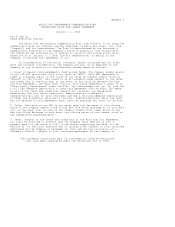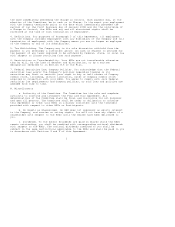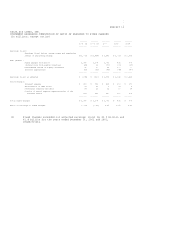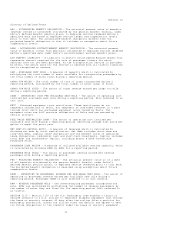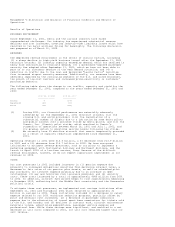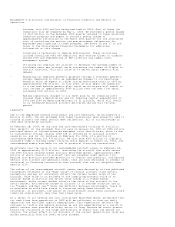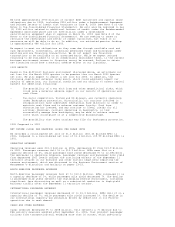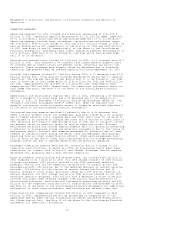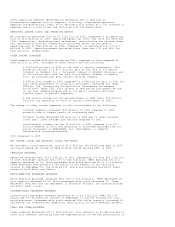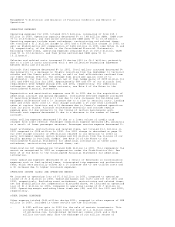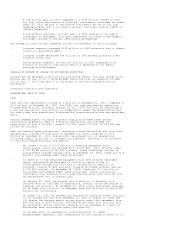Delta Airlines 2002 Annual Report Download - page 110
Download and view the complete annual report
Please find page 110 of the 2002 Delta Airlines annual report below. You can navigate through the pages in the report by either clicking on the pages listed below, or by using the keyword search tool below to find specific information within the annual report.Management's Discussion and Analysis of Financial Condition and Results of
Operations
savings, with $250 million being realized in 2003. Most of these job
reductions will be complete by May 1, 2003. We recorded a pretax charge
of $127 million in the December 2002 quarter related to these workforce
reduction programs and expect to record a pretax charge of
approximately $43 million in the March 2003 quarter for the associated
cost of curtailing the pension and postretirement obligations for
employees participating in these programs. See Notes 16 and 17 of the
Notes to the Consolidated Financial Statements for additional
information on this charge.
- Investing in technology to improve efficiencies. These initiatives
include installing over 400 additional self-service kiosks in airports
during 2003 and implementing an SAP inventory and supply chain
management system.
- Utilizing our regional jet aircraft to decrease the average number of
available seats per aircraft while increasing the number of flights in
certain locations. This will allow us to better match capacity with
demand.
- Modifying our employee benefits programs through a strategic benefits
review. Beginning in 2003, we implemented changes to our healthcare
benefits which we expect to offset rising healthcare costs in 2003 by
approximately $80 million. In July 2003, we will begin the migration
to a new cash balance pension plan, which we anticipate will result in
cost savings of approximately $600 million over the next five years,
including $120 million in 2003.
- Making significant changes to our fleet plan by (1) reducing costs
through fleet simplification and (2) reducing capital expenditures in
2003 and 2004 by deferring delivery of 31 aircraft, which will result
in no scheduled mainline aircraft deliveries during this two-year
period.
LIQUIDITY
Due to the depressed revenue environment and cost pressures, we borrowed $2.6
billion in 2002. The net proceeds from these transactions were primarily used to
finance aircraft and repay certain debt obligations. All of our borrowings in
2002 were secured by aircraft.
At February 28, 2003, we had cash and cash equivalents totaling $1.9 billion.
This reflects (1) the proceeds from our sale on January 30, 2003 of $392 million
principal amount of insured enhanced equipment trust certificates, which is due
in installments through January 2008 and is secured by 12 mainline aircraft
owned by us, and (2) our purchase on February 25, 2003, of a portion of
outstanding ESOP Notes for $74 million. We also have $500 million of liquidity
available under a secured credit facility which expires on August 21, 2003, and
unencumbered assets available for use in potential financing transactions.
We estimate that the value of our unencumbered aircraft assets at February 28,
2003 is approximately $3.6 billion, (excluding the aircraft that would secure
the $500 million secured credit facility described above), approximately $800
million of which consists of aircraft that are eligible under Section 1110.
Because this provision provides protection to lessors and creditors, and because
Section 1110 aircraft are generally newer, they are more desirable to lenders as
collateral in financing transactions than aircraft that are not eligible under
Section 1110.
The values of our unencumbered aircraft assets were derived by us from published
third-party estimates of the "base value" of similar aircraft using certain
assumptions and may not accurately reflect the current market value of the
aircraft. Base value is an estimate of the underlying economic value of an
aircraft based on historic and future value trends in a stable market
environment, while current market value is the value of the aircraft in the
actual market; both methods assume an aircraft is in average condition and in
its "highest and best use." Given the difficult business environment, there is
no assurance we would have access to financing using these aircraft as
collateral. In any event, the amount we could finance using these aircraft would
likely be significantly less than their base value.
As a result of our revenue and cost initiatives described above, we believe that
our cash flows from operations in 2003 will be sufficient to fund our daily
operations and non-fleet capital expenditures. This expectation reflects the
softness in traffic and advance bookings we are now experiencing as a result of
public concern over possible military action in Iraq. Because we cannot predict
either the occurrence or the scope and duration of events that are beyond our
control, the actual effect on our business of the current geopolitical risks may
differ materially from the level we have assumed.


